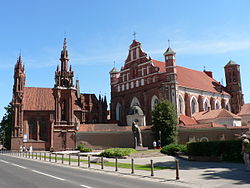St. Anna (Vilnius)
| St. Anne and Bernhardine Annenkirche |
|
|---|---|
 Exterior view (facade design) |
|
| Data | |
| place | Vilnius |
| builder | Benedikt Ried |
| Construction year | 1495-1500 |
| Coordinates | 54 ° 40 '59.1 " N , 25 ° 17' 35.5" E |
The Roman Catholic Church of St. Anne ( Lithuanian Šv. Onos bažnyčia ; officially St. Anne and Bernhardine) is an important church in the Lithuanian capital Vilnius . It replaced a wooden church which was destroyed in a fire in 1419. The construction of today's church goes back to the Grand Duke Alexander Jagiellon .
The church is a rare example of Gothic in Lithuania , here even in the "flaming" Gothic style . A combination of straight and curved lines can be found especially on the main facade, but also on the sides. Pilasters , four bundles, slender rods, openwork towers and three different types of arches (round, pointed and curved) determine the facade design. Possibly the facade design symbolizes the columns of Gediminas , one of the oldest known Lithuanian symbols. Apart from several renovations, the shape of the red brick church has remained practically unchanged since the 15th century. The exact construction dates are not known, but could be dated between 1495 and 1500. The lead architect was the Bohemian Benedikt Ried , who also created parts of the Prague Castle . The exterior consists of 33 different types of brick and is considered a masterpiece of the Lithuanian Gothic.
While the exterior is very expressive, the interior is simpler. The reason for the unadorned interior of the church is looting and devastation during the Napoleonic period. The very simple, single-nave interior is decorated with baroque side altars. The vaults bear the signature of the 20th century. The highlight in the interior are the colored windows.
The church ensemble includes the free-standing neo-Gothic bell tower by Nikolai Tashagin from the 19th century and the baroque chapel of the holy stairs from the 17th century. The chapel belongs more to the Bernhardinerkirche (officially St. Franziskus and Bernhard). It is one of the largest Gothic churches in the city, which was supplemented in baroque style, and therefore forms an exciting ensemble of three churches. Along with the rest of the old town, the church is since 1994 a World Heritage Site by UNESCO . Restorations took place in 1902–1909 and 1960–1970. The roof, facade elements and the side turrets have been restored again since 2009.
reception
Web links
- sightseeing-vilnius.com (German)
- inyourpocket.com (English)

